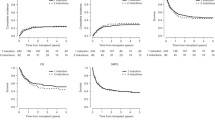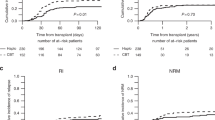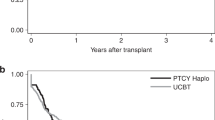Abstract
Single-unit umbilical cord blood (CB) SCT is limited by low total nucleated cell (TNC) dose. Co-infusion of CD34+ cells from a third party HLA-mismatched donor, known as dual or haplo-cord transplant, reduces the period of post-transplant neutropenia and related complications. The aim of this study was to analyze the value of early post-transplant peripheral blood (PB) and T cell chimerism after 28 dual transplants regarding CB engraftment. Cumulative incidence of myeloid engraftment at 30 days was 93% with a median time to engraftment of 14 days (10–29). Patients who developed CB graft failure (n=5) showed very low percentages of CB cells on days +14, +21 and +28 with decreasing dynamics. On the other hand, percentages of CB cells in patients who achieved CB engraftment increased over time. Interestingly, such patients showed two distinct chimerism dynamics in PB, but all of them showed a predominance of CB T cells early after SCT with increasing dynamics over time. Early post-transplant chimerism dynamics in PB and T cells predicts CB graft failure enabling rapid therapeutic measures to be applied. On the other hand, early increasing percentages of CB T cells correlates with ultimate CB engraftment.
This is a preview of subscription content, access via your institution
Access options
Subscribe to this journal
Receive 12 print issues and online access
$259.00 per year
only $21.58 per issue
Buy this article
- Purchase on Springer Link
- Instant access to full article PDF
Prices may be subject to local taxes which are calculated during checkout



Similar content being viewed by others
References
Rocha V, Labopin M, Sanz G, Arcese W, Schwerdtfeger R, Bosi A et al. Transplants of umbilical-cord blood or bone marrow from unrelated donors in adults with acute leukemia. N Engl J Med 2004; 351: 2276–2285.
Eapen M, Rocha V, Sanz G, Scaradavou A, Zhang M-J, Arcese W et al. Effect of graft source on unrelated donor haemopoietic stem-cell transplantation in adults with acute leukaemia: a retrospective analysis. Lancet Oncol 2010; 11: 653–660.
Sanz J, Boluda JCH, Martín C, González M, Ferrá C, Serrano D et al. Single-unit umbilical cord blood transplantation from unrelated donors in patients with hematological malignancy using busulfan, thiotepa, fludarabine and ATG as myeloablative conditioning regimen. Bone marrow transplantation 2012; 47: 1287–1293.
Laughlin MJ, Eapen M, Rubinstein P, Wagner JE, Zhang M-J, Champlin RE et al. Outcomes after transplantation of cord blood or bone marrow from unrelated donors in adults with leukemia. New Engl J Med 2004; 351: 2265–2275.
Fernández MN, Regidor C, Cabrera R, García-Marco JA, Forés R, Sanjuán I et al. Unrelated umbilical cord blood transplants in adults: early recovery of neutrophils by supportive co-transplantation of a low number of highly purified peripheral blood CD34+ cells from an HLA-haploidentical donor. Exp Hematol 2003; 31: 535–544.
Bautista G, Cabrera JR, Regidor C, Forés R, García-Marco JA, Ojeda E et al. Cord blood transplants supported by co-infusion of mobilized hematopoietic stem cells from a third-party donor. Bone Marrow Transplant 2009; 43: 365–373.
Kwon M, Balsalobre P, Serrano D, Pérez Corral A, Buño I, Anguita J et al. Single cord blood combined with HLA-mismatched third party donor cells: comparable results to matched unrelated donor transplantation in high-risk patients with hematologic disorders. Biol. Blood Marrow Transplant 2012; 19: 143–149.
Liu H, Rich ES, Godley L, Odenike O, Joseph L, Marino S et al. Reduced-intensity conditioning with combined haploidentical and cord blood transplantation results in rapid engraftment, low GVHD, and durable remissions. Blood 2011; 118: 6438–6445.
Mattsson J, Ringdén O, Storb R. . Graft Failure after Allogeneic Hematopoietic Cell Transplantation. Biol. Blood Marrow Transplant 2008; 14 (Supple 1): 165–170.
Rocha V, Cornish J, Sievers EL, Filipovich A, Locatelli F, Peters C et al. Comparison of outcomes of unrelated bone marrow and umbilical cord blood transplants in children with acute leukemia. Blood 2001; 97: 2962–2971.
Atsuta Y, Suzuki R, Nagamura-Inoue T, Taniguchi S, Takahashi S, Kai S et al. Disease-specific analyses of unrelated cord blood transplantation compared with unrelated bone marrow transplantation in adult patients with acute leukemia. Blood 2009; 113: 1631–1638.
Rondón G, Saliba RM, Khouri I, Giralt S, Chan K, Jabbour E et al. Long-term follow-up of patients who experienced graft failure postallogeneic progenitor cell transplantation. Results of a single institution analysis. Biol. Blood Marrow Transplant 2008; 14: 859–866.
Guardiola P, Kuentz M, Garban F, Blaise D, Reiffers J, Attal M et al. Second early allogeneic stem cell transplantations for graft failure in acute leukaemia, chronic myeloid leukaemia and aplastic anaemia. French Society of Bone Marrow Transplantation. Br. J. Haematol 2000; 111: 292–302.
Waki F, Masuoka K, Fukuda T, Kanda Y, Nakamae M, Yakushijin K et al. Feasibility of reduced-intensity cord blood transplantation as salvage therapy for graft failure: results of a nationwide survey of adult patients. Biol. Blood Marrow Transplant 2011; 17: 841–851.
Fuji S, Nakamura F, Hatanaka K, Taniguchi S, Sato M, Mori S-I et alPeripheral Blood as a Preferable Source of Stem Cells for Salvage Transplantation in Patients with Graft Failure after Cord Blood Transplantation: A Retrospective Analysis of the Registry Data of the Japanese Society for Hematopoietic Cell Transplantation. Biology of blood and marrow transplantation: journal of the American Society for Blood and Marrow Transplantation [Internet]. 2012 Mar 16 [cited 2012 Jun 19]; Available from: http://www.ncbi.nlm.nih.gov/pubmed/22430086.
Wagner JE, Barker JN, DeFor TE, Baker KS, Blazar BR, Eide C et al. Transplantation of unrelated donor umbilical cord blood in 102 patients with malignant and nonmalignant diseases: influence of CD34 cell dose and HLA disparity on treatment-related mortality and survival. Blood 2002; 100: 1611–1618.
Takanashi M, Atsuta Y, Fujiwara K, Kodo H, Kai S, Sato H et al. The impact of anti-HLA antibodies on unrelated cord blood transplantations. Blood 2010; 116: 2839–2846.
Page KM, Zhang L, Mendizabal A, Wease S, Carter S, Gentry T et al. Total colony-forming units are a strong, independent predictor of neutrophil and platelet engraftment after unrelated umbilical cord blood transplantation: a single-center analysis of 435 cord blood transplants. Biol. Blood Marrow Transplant 2011; 17: 1362–1374.
Dubovsky J, Daxberger H, Fritsch G, Printz D, Peters C, Matthes S et al. Kinetics of chimerism during the early post-transplant period in pediatric patients with malignant and non-malignant hematologic disorders: implications for timely detection of engraftment, graft failure and rejection. Leukemia 1999; 13: 2060–2069.
Cimino G, Rapanotti MC, Elia L, Iori AP, Guglielmi C, Screnci M et al. A prospective molecular study of chimaerism in patients with haematological malignancies receiving unrelated cord blood or bone marrow transplants: detection of mixed chimaerism predicts graft failure with or without early autologous reconstitution in cord blood recipients. Br. J. Haematol 1999; 104: 770–777.
Chan KW, Grimley MS, Taylor C, Wall DA. . Early identification and management of graft failure after unrelated cord blood transplantation. Bone Marrow Transplant 2008; 42: 35–41.
Moscardó F, Sanz J, Senent L, Cantero S, de la Rubia J, Montesinos P et al. Impact of hematopoietic chimerism at day +14 on engraftment after unrelated donor umbilical cord blood transplantation for hematologic malignancies. Haematologica 2009; 94: 827–832.
Breuer S, Preuner S, Fritsch G, Daxberger H, Koenig M, Poetschger U et al. Early recipient chimerism testing in the T- and NK-cell lineages for risk assessment of graft rejection in pediatric patients undergoing allogeneic stem cell transplantation. Leukemia 2012; 26: 509–519.
Newell LF, Milano F, Nicoud IB, Pereira S, Gooley TA, Heimfeld S et alEarly CD3 Peripheral Blood Chimerism Predicts the Long-Term Engrafting Unit Following Myeloablative Double-Cord Blood Transplantation. Biology of blood and marrow transplantation: journal of the American Society for Blood and Marrow Transplantation [Internet]. 2012 Feb 8 [cited 2012 Jun 20]; Available from: http://www.ncbi.nlm.nih.gov/pubmed/22326302.
Buño I, Anta B, Moreno-López E, Balsalobre P, Balas A, García-Sánchez F et al. Lineage-specific chimaerism quantification after T-cell depleted peripheral blood stem cell transplantation. Leuk. Lymphoma 2003; 44: 659–667.
Buño I, Nava P, Simón A, González-Rivera M, Jiménez JL, Balsalobre P et al. A comparison of fluorescent in situ hybridization and multiplex short tandem repeat polymerase chain reaction for quantifying chimerism after stem cell transplantation. Haematologica 2005; 90: 1373–1379.
Díez-Martín JL, Gómez-Pineda A, Serrano D, Carrión R, Balsalobre P, Buño I . Successful treatment of incipient graft rejection with donor leukocyte infusions, further proof of a graft versus host lymphohaemopoietic effect. Bone Marrow Transplant 2004; 33: 1037–1041.
Bader P, Kreyenberg H, Hoelle W, Dueckers G, Kremens B, Dilloo D et al. Increasing mixed chimerism defines a high-risk group of childhood acute myelogenous leukemia patients after allogeneic stem cell transplantation where pre-emptive immunotherapy may be effective. Bone Marrow Transplant 2004; 33: 815–821.
Ho VT, Soiffer RJ. . The history and future of T-cell depletion as graft-versus-host disease prophylaxis for allogeneic hematopoietic stem cell transplantation. Blood 2001; 98: 3192–3204.
Avery S, Shi W, Lubin M, Gonzales AM, Heller G, Castro-Malaspina H et al. Influence of infused cell dose and HLA match on engraftment after double-unit cord blood allografts. Blood 2011; 117: 3277–3285 quiz 3478.
Acknowledgements
We wish to thank José María Bellón from the Instituto de Investigación Sanitaria Gregorio Marañón for statistical analysis. This work was partially supported with grants (PI05-2505, PI08-1463, PI11-007089, RD12/0036/0061) from the Fondo de Investigaciones Sanitarias, Instituto de Salud Carlos III, Spain and the Spanish Association Against Cancer.
Author information
Authors and Affiliations
Corresponding author
Ethics declarations
Competing interests
The authors declare no conflict of interest.
Additional information
Author Contributions
Conception and design: MK and IB. Provision of study materials or patients: MK, CML and IB. Collection and assembly of data: MK, CML, PB and IB. Data analysis and interpretation: All authors. Manuscript writing: MK and IB. Final approval of manuscript: All authors.
Supplementary Information accompanies this paper on Bone Marrow Transplantation website
Supplementary information
Rights and permissions
About this article
Cite this article
Kwon, M., Martínez-Laperche, C., Balsalobre, P. et al. Early peripheral blood and T-cell chimerism dynamics after umbilical cord blood transplantation supported with haploidentical cells. Bone Marrow Transplant 49, 212–218 (2014). https://doi.org/10.1038/bmt.2013.177
Received:
Revised:
Accepted:
Published:
Issue Date:
DOI: https://doi.org/10.1038/bmt.2013.177
Keywords
This article is cited by
-
Engraftment kinetics after transplantation of double unit cord blood grafts combined with haplo-identical CD34+ cells without antithymocyte globulin
Leukemia (2021)
-
Cord blood transplants supported by unrelated donor CD34+ progenitor cells
Bone Marrow Transplantation (2020)
-
Alternative Donor Transplantation—“Mixing and Matching”: the Role of Combined Cord Blood and Haplo-Identical Donor Transplantation (Haplo-Cord SCT) as a Treatment Strategy for Patients Lacking Standard Donors?
Current Hematologic Malignancy Reports (2015)



